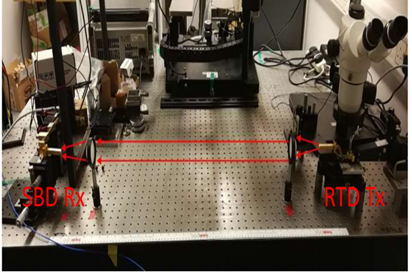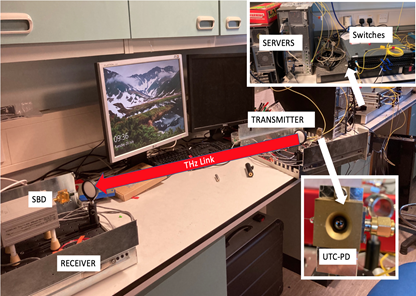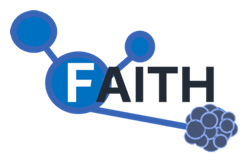TERAPOD project: final review and outcomes
Tags:
TERAPOD was a Horizon 2020 project funded by the European Commission (EC). The project aimed to investigate and demonstrate the feasibility of ultra-high bandwidth wireless access networks operating in the terahertz (THz) band. The proposed TERAPOD THz communication system would be developed, driven by “beyond 5G” (B5G) usage scenario requirements, would be demonstrated in a “first adopter” operational setting (a data centre) and would significantly progress innovations across the whole communications protocol stack. The project consortium consisted of academics and industry leaders from Ireland, the UK, Spain, Portugal and Germany.
The TERAPOD project final review meeting took place on 8th September 2021, during which TERAPOD partners presented their achievements including:
- Top-of-Rack Networking models (TOR)
- Simulators
- New THz devices developed and packaged (Emitters, receivers, LNA, antenna)
- Demonstration of Terahertz(THz) communication suitable for data center scenario.
After one day of fruitful discussion with EC reviewers, feedback was positive and encouraging. The project outcomes are aligned with European efforts to develop the next sixth generation wireless network (6G); the THz band will be an enabler of 6G.
TERAPOD’s consortium included 11 partners from Europe, with Waterford Institute of Technology leading the project and responsible for WP1 (project management) and WP5 (communication protocols). The goal of TERAPOD was achieved through four key objectives:
Objective 1: Advance the Technology Readiness Level (TRL) of THz communication devices and systems, out of the lab and towards industrial and SME uptake, within the context of beyond 5G usage scenario requirements.
Objective 2: Demonstrate the feasibility of THz communication systems in beyond 5G scenarios through a fully integrated ‘first adopter’ Data Center demonstrator.
Objective 3: Address the non-technical barriers to adoption of THz communication in the areas of Regulation and Standardisation.
Objective 4:. Promote scientific research and innovation of THz communications systems in Europe.
The final outcomes of TERAPOD include:
- Fully packaged Uni-Travelling Carrier Photodiode emitters (UTC-PDs) operating at 300 GHz
- 300 GHz Resonnant Tunneling Diodes (RTD) emitters beyond SotA DC-RF conversion efficiency (<1 % to >10 %) , epitaxial design and power > 10 mW
- At the receiving side, Novel Schottky Barrier Diode (SBD) operating at frequency band 270-320 GHz, were developed and successfully designed with RTD and UTC.
- Design and fabrication of 300 GHz Benzocyclobutene (BCB) based 1-by-4 planar array antenna suitable for integration with sub-THz devices
- Development of Photonic Integrated Circuit (PIC) for phase control and THz beam steering
- THz Device and channel characterization
- Development of new THz models based on channel measurement and new communication techniques and protocols and integration on a network simulator
- Contribution in THz communication standards (IEEE 802.15)
During the final review, 3 demonstrations were presented:
- Simulation demonstration of 4-by-4 TOR THZ network with assessment of Signal to Interference and Noise Ratio (SINR), throughput and Bit Error Rate (BER)
- Physical demonstration of 12 Gbps THz link at 1 m using RTD (electronic emitter) and SBD (Fig.1)
- Physical demonstration of 100 Gbps THz link (4X25 Gbps) at 10m using UTC (optical emitter) and SBD (Fig.2)


For more information on the TERAPOD project and outcomes please visit the project website: https://terapod-project.eu/




